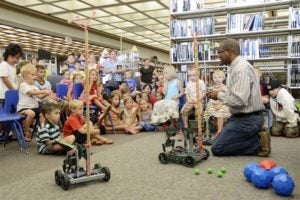
STEM (Science, Technology, Engineering and Math) has become a hot topic in education. Schools all over the country are finding ways to enrich students in these key subject areas.
Why is STEM important? The U.S. Department of Commerce claims that STEM careers are growing at a rate of 17%, which is almost double the growth rate of non-STEM careers. STEM jobs are those that will be most available for graduates and provide higher income than non-STEM degrees. Even though these jobs are and will continue to be in high demand, U.S. students may not be up to the task. Recently released data from international science and math assessments show that U.S. students fall behind students of other industrialized nations in math and science scores. Integrating STEM into the curriculum may help to bridge that gap.
Many educators believe that STEM more naturally lends itself to older students, but elementary aged students are very capable of engaging in STEM activities. Here are some tips for bring STEM into any classroom, including elementary!
- Make it fun!
STEM activities work best when kids can be active participants in their learning. Learn about wind power by making LEGO cars. Build 3D structures. Create a volcano. Explode some Mentos. Whatever you do, require students to create a hypothesis and test it. Let them get their hands dirty and think critically. You can find great hands-on learning lessons in science and math in the Lesson Plans section of the Educator Resources page.
- Integrate STEM throughout the curriculum.
Some teachers may be thinking, “I don’t have time to teach anything else!” Don’t worry! You don’t have to. STEM is most effective as a part of the great things you are already doing. If you think about it, STEM is a part of our lives every day. Every time you check your email, determine how many additional plates you can stack in your sink or pay your bills, you are using STEM skills. Take a look at your standards and lessons and see where you can fit in a STEM activity. It is easy!
- Invite experts into your classroom!
“Career Day” is a bit of an old concept in education, but kids really do benefit from hearing adults talk about their work. Reach out to STEM professionals in your area about speaking to your students. Start with the parents and family members of your students! Ask them to speak about what they do each day, what they like about their jobs and the skills they use. If you have a difficult time finding STEM professionals in your school community, reach out to local businesses, colleges and universities for help.
- Focus on project-based learning (PBL).
Project-based learning is a learning method in which students learn by investigating and responding to complex questions or problems using critical thinking skills. Project-based learning is great for all types of learners and is an authentic way to teach STEM. Give students real world problems to solve and step out of the way while they tackle them.
- Get some training.
Do you feel like you are struggling to understand STEM? There are tons of professional development opportunities available to teachers. You can learn more about what STEM is, how to use it and specific activities to use in the classroom.
Center for Stem Education for Girls keeps a running list of professional development opportunities across the country.
Luma Brighter Learning offers STEM professional development online.
You can also check with your local community/technical colleges or universities. They sometimes offer STEM classes for teachers as well. Professional development can be a great way to learn about STEM for the first time or to learn new things about STEM!
If utilizing STEM in your classroom makes you nervous, start small. Once you see the great benefit it has on your students, it will be easier to ease in!
References
Desilver, D. (2017, February 15). U.S. students’ academic achievement still lags that of their peers in many other countries. Retrieved from http://www.pewresearch.org/fact-tank/2017/02/15/u-s-students-internationally-math-science/.
STEM Education Professional Development Online. (n.d). Retrieved from https://learnwithluma.com/stem-professional-development/.
Teacher Professional Development Opportunities. (n.d.) Retrieved from http://stemefg.org/index.php/resources/teacher-professional-development-opportunities.
U.S. Department of Commerce. (2011, July 14). STEM: Good Jobs Now and For the Future. Retrieved from http://www.esa.doc.gov/reports/stem-good-jobs-now-and-future.

